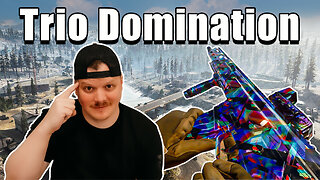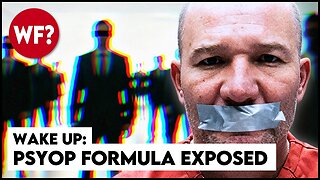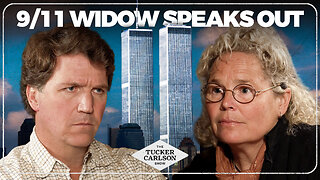Premium Only Content

Thirty Minutes of Gunfire Just Changed EVERYTHING in Lebanon
Right, so Israel have been busy redrawing borders in their favour again, and they didn’t even bother pretending otherwise this time. The UN has measured the concrete, mapped the breaches, and written down exactly where Israel has shoved its latest wall across the Blue Line. Lebanon has filed the complaint, UNIFIL has logged the violations, and the only people acting surprised are the ones who always act surprised when Israel helps itself to land that isn’t theirs. And just to underline the point, when peacekeepers went out to verify the second breach, an Israeli tank positioned inside Lebanon opened fire and put rounds about five metres from their boots. You don’t need a panel discussion to work out what’s going on here. Israel builds where it wants, denies it’s done it, expands it anyway, says its their right and even fires at the UN when the UN tries to prove it. Well its not like the UN will do anything I suppose is it?
Right, so Israel has been building walls inside Lebanon now, and the UN has measured every metre of it. That’s where this story starts. You don’t need speculation, you don’t need political spin, you don’t need to guess what’s going on, because the only people with the legal authority to determine whether the Blue Line, the border between the two states, has been crossed are the UN peacekeepers whose entire mandate is built on maintaining that boundary. And those peacekeepers have now mapped not one, but several Israeli structures that fall inside Lebanese territory. They’ve logged the coordinates, they’ve produced the geospatial surveys, they’ve issued the warnings, they’ve told the Israeli army to stop, and Israel hasn’t stopped. In fact, it’s done the opposite. It has carried on, expanded the wall, produced a second breach, dug in a tank position north of the Blue Line, and then fired on the peacekeepers who were documenting the violations. That’s the story. You can soften it if you want, you can wrap it in euphemisms about “tensions” and “misunderstandings” like Western media usually does when Israel crosses lines it isn’t supposed to cross, it’s a BBC script in the making isn’t it? But the facts don’t change. Israel is redrawing the border with Lebanon by force, the UN has the proof, and the moment peacekeepers tried to record the latest breach, Israel put heavy machine-gun fire around their feet.
The Blue Line has always been fragile. It’s a UN-demarcated boundary, not a negotiated border, mapped most recently in 2000 when Israel withdrew from south Lebanon and reaffirmed under Resolution 1701 after the 2006 war. It’s supposed to be fixed, neutral, and respected by both sides. And that’s why UNIFIL has been stationed there for decades: to make sure nobody quietly pushes the line one way or another, because that’s how wars start. The Line isn’t guesswork. It isn’t a dotted sketch where states can scribble their own interpretation. It’s pinned down with GPS coordinates, marked on the ground with blue barrels and stakes, and monitored constantly. So when UNIFIL says a wall is over the Line, it’s not an argument. It’s a measurement.
Last month, UN peacekeepers surveyed a new concrete T-wall Israel had built southwest of Yaroun. The survey found that the wall didn’t just run parallel to the Blue Line, it crossed it. And the moment it crossed it, it became an incursion. Not a dispute. Not a misunderstanding. An incursion. And the size of that incursion wasn’t trivial. The UN measured more than 4,000 square metres of Lebanese land that had become inaccessible because the wall now sat on the wrong side of the line. That’s farmland, private land, grazing land, whatever use those families depended on. And once again, that number isn’t a political claim; it’s a UN figure recorded by geospatial teams whose job is to verify exactly these situations. Local residents can’t access their own territory because a foreign army has put a barrier across it. And Israel’s response was the same as it always is when caught in the act: denial. It said the wall didn’t cross the Blue Line. It said UNIFIL was mistaken. It said the construction was part of “ongoing border infrastructure” begun in previous years. And you know how this goes, because it’s the formula. Deny first. Deny again. Claim security. Claim necessity. Carry on building.
UNIFIL wasn’t confused, though. And it wasn’t waiting. Peacekeepers went back this month and surveyed another section of the same barrier, farther along toward Yaroun’s southeastern side. That section also crossed the Blue Line. So now there wasn’t one breach. There were two. Two measured crossings. Two segments of wall inside Lebanon. Two violations of 1701. And two moments where Israel could have chosen to pull the wall back and didn’t. And this is where you can see the broader pattern, because Israel has done this before in Gaza: small expansions of a buffer zone, followed by denial, followed by quiet acceptance, followed by expansion again. You build where you shouldn’t, you pretend you didn’t, and you wait to see if anyone stops you. If nobody stops you, you keep going. That’s what is happening here.
And if you thought the Yaroun breaches were the end of it, they weren’t. UNIFIL documented yet another wall under construction between Aytaroun and Maroun ar-Ras. This statement I have to say is confusing, because if the wall is between these two settlements, just north of the blue line, then its in Lebanon, but UNIFIL in their official statement claim it is south of the blue line, which means it would be in Israel, but that also means it couldn’t be between the two settlements, so I’m not clear, but given they’ve reported on it, surely that means its in Lebanon? Odd. Needs clarifying that. Anyway, despite that confusion, by this point, the pattern nevertheless isn’t so much emerging; being fully visible instead. Multiple construction points. Multiple breaches. Multiple expansions. And UN peacekeepers confirming them all.
So UNIFIL told the IDF all of this directly. They informed Israel the wall had crossed the Line. They said the wall must be dismantled. They said the expansions must stop. They said Israel must withdraw from all areas north of the Line. And Israel didn’t comply. It didn’t even pause. The construction continued. And so the Lebanese state escalated it diplomatically. President Joseph Aoun ordered an urgent complaint be filed with the UN Security Council, well that will be a fat lot of good. It wasn’t just rhetorical protest though; it included the UN’s own survey findings, because Lebanon wanted to place Israel’s denial and the UN’s evidence side by side on the highest legal stage possible. You don’t do that unless you intend to move the dispute from the military field to the diplomatic one. The complaint itself is a political act, a marker that says: “We will not accept a new border carved in concrete by force.” If the UN does anything more than hand-wringing though I will be amazed.
But if the wall-building exposed Israel’s creeping annexation — and yes, annexation is the correct term when a state builds infrastructure inside territory it doesn’t own — then what happened next exposed the method of enforcement. Because walls aren’t just structures; they’re statements backed by force. And on 16 November, that force was a Merkava tank stationed north of the Blue Line, inside Lebanese land, near one of the wall positions Israel had created.
UNIFIL peacekeepers were on foot. They weren’t carrying weapons ready for combat. They weren’t in armour. They weren’t hidden. They were doing what they always do: routine verification patrols, following established routes, in UN-marked gear, in daylight, in open terrain, and well known to the IDF through liaison channels. Then the tank fired heavy machine-gun rounds toward them. The rounds landed roughly five metres from where they stood. Five metres is the difference between warning and murder. Five metres means the tank crew knew exactly where the peacekeepers were and chose to place rounds close enough to trap them. It wasn’t a ricochet. It wasn’t a distant shot. It was a deliberate proximity.
The peacekeepers had to take shelter and contact the IDF through UNIFIL liaison channels. The firing didn’t stop immediately. It didn’t stop within seconds. It continued until the liaison channel managed to intervene, and even then, the tank didn’t pull back instantly. It withdrew only after roughly thirty minutes. And if you’re still holding out hope that this was a mistake, look at that timeline again. Misidentification doesn’t last half an hour. Accidents don’t require thirty minutes of sustained intervention. A mistaken shooter doesn’t keep firing near a UN-marked patrol while the UN is literally telling them to stop. And the UN knows this. Which is why UNIFIL described it as a “serious violation” of 1701 and demanded Israel cease “aggressive behaviour and attacks on or near peacekeepers”.
So, strip away the excuses. Strip away the language Israel uses when caught out, like “suspected hostile movement” or “fog of war” or “identification error”. Because none of those explanations survive contact with the facts. The tank was inside Lebanon. The peacekeepers were on foot, on a known route, wearing UN insignia, in daylight, documented through GPS and liaised through official channels. And the firing continued for half an hour. And the tank only withdrew once the UN forced the issue. That isn’t misidentification. It’s coercion.
And this is where the whole picture comes together, because when you put the pieces in chronological order, the story is brutally simple. October: Israel builds a wall into Lebanon. UNIFIL measures it. November: Israel has expanded the wall. UNIFIL measures it again. Lebanon files a complaint. Then a tank inside Lebanon opens fire on the peacekeepers verifying those breaches. That’s the sequence. Israel builds. Israel denies. Israel expands. Lebanon escalates diplomatically. Israel fires. And when peacekeepers have to call for the firing to stop, you’re not dealing with friction. You’re dealing with enforcement. The wall is being protected by force.
And here’s the political truth that sits underneath all of this: borders don’t usually change with declarations. They change with roads, fences, walls, outposts, trenches, and tanks, and they change in the moments where the international community looks away or decides that a small slice of land isn’t worth a confrontation. Israel knows that. It has always known it. “Facts on the ground” isn’t just a phrase; it’s a policy doctrine. And you’re watching it unfold on the Lebanese frontier. The difference this time is that the UN has caught it in real time and written it down. They’ve mapped the breach. They’ve named the violation. They’ve logged the firing. They’ve called it a “serious violation”. And they’ve told Israel to withdraw. What would make a change would be some enforcement for once though.
The problem is that UNIFIL themselves can’t enforce removal. Lebanon can’t force the wall back. The UN Security Council will not sanction Israel. And Israel knows all of that, which is why it keeps moving concrete deeper into Lebanon and dealing with peacekeepers by suppressive fire rather than compliance. You don’t need to wonder why the walls are being built. The reason is already visible in the tank fire. If you are willing to fire at the UN, you’re willing to enforce an illegal wall. And if you’re willing to enforce an illegal wall, you’re willing to keep expanding it.
This is the border being rewritten. Not through negotiation. Not through treaty. Not through diplomacy. Through construction. Through denial. Through expansion. Through armoured enforcement. Through quiet acceptance from the international arena. And through the simple fact that Lebanon doesn’t have the military leverage to push Israel back, and the UN doesn’t have the mandate to do it either, because the Security Council, with that US veto, will never sanction it. Which leaves Israel with one calculation: “If no one can stop us, why stop?”
And that’s the real danger here, because once a state realises it can alter an international boundary and fire on the peacekeepers documenting it without suffering consequences, the restraint evaporates. The Blue Line becomes optional. 1701 becomes symbolic. UNIFIL becomes a witness instead of a deterrent. And Lebanon becomes a frontier where Israel can carve out whatever operational depth it wants.
This isn’t a misunderstanding. This isn’t a border dispute. This isn’t the usual cross-line friction. This is a land grab, logged in concrete, mapped by the UN, escalated by armoured fire, and carried out in the knowledge that the only people with the authority to stop it are the people being shot at while they try to do that job.
That’s the truth. And the truth has a consequence. If this wall stays where it is, the Blue Line won’t be a boundary anymore. It’ll be whatever Israel’s next construction team decides it should be. And once a border moves like that, the risks stop being hypothetical. They become structural. And once they’re structural, they’re permanent.
It's yet another blow to the ceasefire, if the peacekeepers aren’t even safe now, if the UN is incapable of stepping in, held to ransom by the US, is it any wonder that Hezbollah won’t disarm as is being demanded in exchange for the peace that Lebanon is already supposed to have? Matters on that score are already coming to a head, will Israeli walls and shots at UNIFIL push it over the edge now? Get all the details of that story here.
Please do also hit like, share and subscribe if you haven’t done so already so as to ensure you don’t miss out on all new daily content as well as spreading the word and helping to support the channel at the same time which is very much appreciated, holding power to account for ordinary working class people and I will hopefully catch you on the next one. Cheers folks.
-
 2:13:31
2:13:31
The Connect: With Johnny Mitchell
1 day ago $17.36 earnedIs Garth Brooks A Serial Killer? Exposing The Dark Secrets Of Country Music's Biggest Star
36.1K16 -
 LIVE
LIVE
Phyxicx
10 hours agoBack to FF8 - Let's actually play the story now! - 11/23/2025
110 watching -
 19:19
19:19
GritsGG
15 hours agoINSANE Trio Match! Most Winning Warzone Player IGLs to Victory!
14.6K1 -
 32:24
32:24
Forrest Galante
1 day agoHunting and Eating The World's WORST Fish (Everglades At Night)
132K9 -
 11:37
11:37
The Pascal Show
1 day ago $14.45 earnedTHEY WANT TO END HER?! Candace Owens Claims French President & First Lady Put A H*t Out On Her?!
55.7K51 -
 LIVE
LIVE
Lofi Girl
3 years agolofi hip hop radio 📚 - beats to relax/study to
297 watching -
 35:40
35:40
The Why Files
5 days agoPsyops: From Dead Babies to UFOs - The Same Pattern Every Time
120K107 -
 1:48:26
1:48:26
Tucker Carlson
2 days agoKristen Breitweiser: 9-11 Cover-Ups, Building 7, and the Billion-Dollar Scam to Steal From Victims
190K423 -
 5:48
5:48
Russell Brand
2 days agoThey BURNED me in effigy!
73.7K45 -
 1:21:40
1:21:40
Man in America
10 hours agoThe Secret AI Plan to Enslave Humanity — And Why It Will FAIL w/ Todd Callender
57.8K26